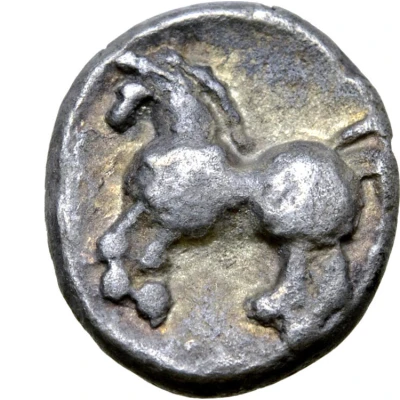


© Roma Numismatics Limited
Obol Karlsteiner Art Type 200 BC - 1 BC
| Silver | 0.66 g | 9 mm |
| Issuer | Kingdom of Noricum |
|---|---|
| Type | Standard circulation coin |
| Years | 200 BC - 1 BC |
| Value | 1 Obol (⅙) |
| Currency | Drachm |
| Composition | Silver |
| Weight | 0.66 g |
| Diameter | 9 mm |
| Shape | Round (irregular) |
| Technique | Hammered |
| Orientation | Variable alignment ↺ |
| Demonetized | Yes |
| Updated | 2024-10-09 |
| Numista | N#192568 |
|---|---|
| Rarity index | 100% |
Reverse
Horse prancing to left.
Comment
Cf. Kos pl. 15, 31;Examples of this type:
• Example #1 (0.66g, 9mm. Extremely Fine):
© Image courtesy of Roma Numismatics Limited
◦ Ex-Hermann Lanz Collection; published in Michaela Kostial - "Kelten im Osten. Gold und Silber der Kelten in Mittel und Osteuropa, Sammlung Lanz", München, 1997, #307;
◦ Auctioned by Roma Numismatics Ltd, Auction XVII, 28 March 2019, Lot 89. Estimated at 50 GBP, unsold.
◦ Auctioned by Numismatik Lanz München, Auction 52, 14 May 1990, lot 49.
• Example #1 (0.40g, 7mm, Good Very Fine):
© Image courtesy of Roma Numismatics Limited
◦ Ex-Hermann Lanz Collection; published in Michaela Kostial - "Kelten im Osten. Gold und Silber der Kelten in Mittel und Osteuropa, Sammlung Lanz", München, 1997, #310;
◦ Auctioned by Roma Numismatics Ltd, E-Sale 60, 1 August 2019, Lot 13. Sold for 40 GBP.
Interesting fact
The Obol coin from the Kingdom of Noricum, made of silver and weighing 0.66g, is interesting because it was used as a form of currency during a time when the Roman Empire was expanding its territories and trade routes. The coin's design, featuring the profile of a king or deity, was influenced by Greek and Roman coinage and reflects the cultural exchange and blending that occurred during this period. Additionally, the fact that it was made of silver, a valuable and durable metal, speaks to the importance of trade and commerce in the region.



